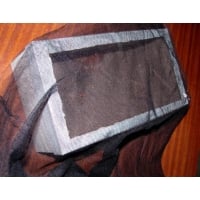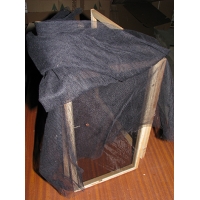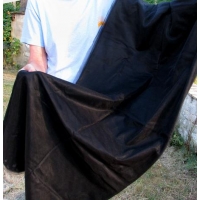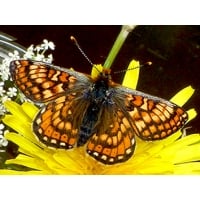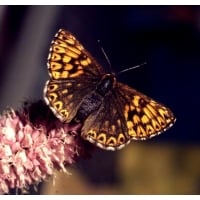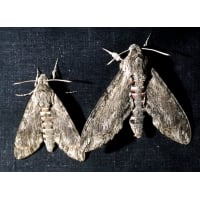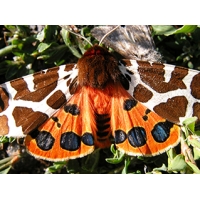Special Offers
Pure Silk hanks These are English reeled 20/22 Denier raw silk hanks produced at the Lullingstone Silk Farm and Worldwide Butterflies.
These fine silk hanks were reeled on the same hand reeling machine, the only one in
The size and weight not standard but the illustration shows a hank picked at random. This is a unique product!
Special temporary promotion price.
NETTING Fine black/grey Nylon 5 metres 150cm wide
Ideal for covering box tops, cages, netting replacement and making sleeves. This soft netting is ideal for making field nets.
Durable, resists tearing and deterioration in UV light. It is fine enough to keep out all but the minutest flies and parasites.
NETTING Fine black/grey Nylon 10 metres 150cm wide
If you are thinking of making a netting structure, cage covering and replacement or making sleeves for rearing larvae, this is the ideal netting.
Durable, resists tearing and deterioration in UV light. It is fine enough to keep out all but the minutest flies and parasites.
NETTING Fine black/grey Nylon 20 metres (2 x 10m) 150cm wide.
Ideal for large structures, flight areas etc.
Use for cage covering or making sleeves for rearing larvae.
Durable, resists tearing and deterioration in UV light. It is fine enough to keep out all but the minutest flies and parasites.
Ordering in 20 metre lots brings the price down very low! 170cm wide.
Marsh Fritillary Eurydryas aurinia
The butterflies fly from May into June. Eggs are laid in large clusters on the underside of Devil’s Bit Scabious.The larvae Feed on Honeysuckle (wild is best), Teasel Snowberry or the natural foodplant Devil’s Bit Scabious. The larvae live in a tightly formed web, growing only a little before they hibernate in autumn.
Marsh Fritillary Eurydryas aurinia
The butterflies fly from May into June. Eggs are laid in large clusters on the underside of Devil’s Bit Scabious.The larvae Feed on Honeysuckle (wild is best), Snowberry or the natural foodplant Devil’s Bit Scabious. The larvae live in a tightly formed web, growing only a little before they hibernate in autumn.
Duke of Burgundy Fritillary Hamearis lucina
It is years since we have had Duke of Burgundy larvae. Now very hard to obtain.
Curious oval larvae like those of the Blues, but not green like those, more a straw colour, with rows of black dots. They live on Primrose or Polyanthus leaves.
Not difficult to rear on a potted plant. Resulting pupae have similar colouring and pattern. Store the pupae in a fridge until May when the delightful butterflies emerge.
Convolvulous Hawkmoth Herse convolvuli
The moths have started breeding. Larvae will follow next month. Not available every year: these are very special!
Huge caterpillars: fascinating to rear. The pupa has a curious proboscis, like a jug handle. Feeds at dusk, Tobacco plants, Petunia, Lillies and Phlox.
Larval Foodplants: Convolvulus, Field Bindweed, Hedge Bindweed, some Morning Glories.
Best reared in Plastic Rearing Containers: see the advice at the heading of that section of the WWB website. Keep at about 25 degrees C. The paper lining and food must be changed EVERY day. Food needs to be very fresh at all times. When larger the larvae may need this change twice a day, due to their productivity!
Larvae pupate in deep compost. Amazing pupae with jug-handle exterior proboscis case!. The pupae may be held cool until next season or incubated to produce moths in a month or two.
Garden Tiger Moth Arctia caja 50 larvae
The price for 50 Woolly Bears has been substantially reduced to encourage releasing in the wild.
Children love them!
Garden Tiger larvae Woolly Bears grow fast on Dock, Dandelion, Dead Nettle, Nettle and many other hedgerow plants, also Pussy Willow Salix caprea and Osier Willow Salix viminalis. You can also feed them conveniently on Cabbage.
Now a most difficult species to obtain.
These are spring and summer larvae. In the wild, late summer larvae would hibernate, but if you keep them warm and light, many will produce another generation this year.
If you wish to hibernate Wooly Bears, sleeve them in autumn on Willow or Sallow (Pussy Willow). The falling leaves curl to form a ventilated ball in which the larvae hibernate. If all goes well in winter the larvae emerge in spring and feed from the new spring leaves.
From October to spring the larvae are in hibernation. Orders are booked for dispatch when the larvae awake and feed.
Cinnabar Moth Hipocrita jacobaeae pupae
Once an extremely common British Moth, less common over most of Europe, but over the last 10 years there has been a marked decline in numbers. The summer of 2016 brought a reversal of this decline and we have a fine stock of pupae available, as a result of breeding.
The larvae feed on Groundsel and Ragwort Senecio. The larvae are ringed in bright orange and black, nature's warning colours, and they absorb chemicals from the foodplant that adversely affect predators who ignore the warning. Ragwort is a mis-understood plant that provides an abundance of nectar to bees, butterflies and other insects. There is evidence that Ragwort plants that are pulled up and left to dry, can be detrimental to cattle and horses if they eat the dried plants. Animals can be seen grazing safely in fields containing growing green plants. There is nothing to be gained from pulling up Ragwort plants, because they are biennials that flower and die in the same year. So a patch of Ragwort can provide valuable nectar to thousands of wild insects, and be host to Cinnabar larvae and, job completed, it dies at the end of summer.
The Cinnabar moth flies by day, more than by night, and is protected from predators, by the very striking colours of charcoal and scarlet, and bitter-tasting chemicals derived from the larval foodplant, enabling the moth to display its bright colours, yet not be attacked by predators.
Cinnabar larvae can be raised in sleeves on growing Ragwort. We find the sleeves fitted with a zip are particularly successful. When the larvae are large, if you put in the sleeve several handfuls of springy wood shavings or dried leaf litter, they will form thin silken cocoons in which to pupate.
Could you help to spread this colourful day-flying moth again in your area?
Store pupae cool for the winter, even in a fridge, loose in a plastic box, without any padding. In May lay them out in an emerging cage and wait for the moths to emerge.


